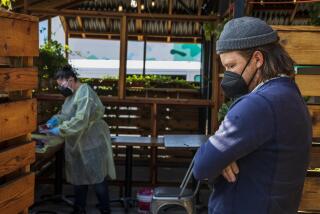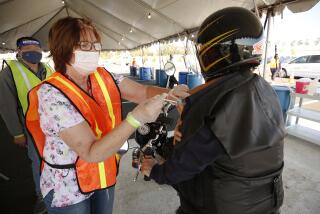Will reopening California bring more coronavirus cases, deaths?

- Share via
SAN FRANCISCO — California is seeing signs that the increase in coronavirus deaths and hospitalizations is slowing, but there remains wide debate about whether the progress is enough to dramatically ease Gov. Gavin Newsom’s stay-at-home order.
The state has recorded its first week-over-week decline in reported COVID-19 deaths, according to a Times data analysis. Two weeks ago, California reported its highest one-week toll — 542 fatalities among people infected with the coronavirus. Last week, the weekly death toll dropped 9% to 495.
Although it was an improvement, last week’s number was still the third-highest over the course of the pandemic.
Even hard-hit parts of the state have seen some relief.
Los Angeles County, home to 55% of California’s COVID-19 deaths despite having only one-quarter of the state’s population, saw its reported weekly death toll flatten for the first time: 315 deaths in each of the past two weeks.
Hospitalizations have been flat on a weekly basis in the five Southern California counties, as well as the San Joaquin Valley and San Diego County, while dropping noticeably in Northern California. L.A. County saw a 2% decline in confirmed and suspected COVID-19 hospitalizations last week compared to the previous week.
Still, California has not seen the sustained 14-day decline in coronavirus cases that the White House has suggested as a key criteria before easing stay-at-home orders. The state reported its highest weekly coronavirus case total April 20-26, with 12,122 cases. Last week, 9,967 cases were reported, an 18% decline but still the second-highest weekly total reported during the pandemic.
Newsom announced Monday that some lower-risk retailers would be allowed to reopen with modifications by Friday — such as sporting good stores and florists for curbside pickup — marking the state’s first major easing of the social distancing rules that have been credited with slowing the spread of the coronavirus and leaving California with far fewer fatalities than hot spots like New York and New Jersey.
But many health officials are urging caution, saying reopening the economy rapidly would cause cases and deaths to increase again.
Santa Clara County executive officer Dr. Jeffrey Smith noted Tuesday that the state death toll is still going up in significant numbers. Last week’s death toll made up nearly one-quarter of California’s cumulative tally of fatalities.
“There’s a lot of talk in California about relaxing shelter-in-place [orders]. I just want to point out that we’re still, in California, going up dramatically,” Smith said. “So there’s no clinical evidence that shelter-in-place should be relaxed at this point.”
Echoing statements by other medical experts, Smith said loosening up the stay-at-home orders will result in more infections and deaths.
With many states significantly relaxing stay-at-home orders, Smith said, the University of Washington’s Institute for Health Metrics and Evaluation is now forecasting a national death toll of more than 134,000 by early August, close to double the current total of more than 71,000. The institute forecasts a California death toll of 4,700 by early August, also roughly double the current number of more than 2,300.
California faces a particular challenge because some parts of the state have been hit much harder than others. Nineteen rural counties have no confirmed deaths, and in some suburban regions the number of deaths has been limited. But Los Angeles County has recorded more than 1,300 deaths and on Tuesday added more than 1,500 new cases — the highest single-day total — to a cumulative total of more than 27,000 cases.
That helped fuel a single-day record of coronavirus cases reported in California, with 2,557 new diagnoses reported, for a cumulative total of 58,724.
“We do know as we reopen, more people will be out and about and we’ll see more cases,” said Los Angeles County public health director Barbara Ferrer. “Nothing has really changed about the virus since March. The virus didn’t get less deadly. The virus didn’t get less infectious. The virus is still out there.”
Dr. Anthony Fauci, director of the National Institute of Allergy and Infectious Diseases, echoed similar concerns on the national level.
“There are regions, areas, counties, cities in which you can [begin to reopen] safely now. But there are others that if you do that, it’s really dangerous,” Fauci said on CNN Monday. “How many deaths — and how much suffering — are you willing to accept to get back to … some form of normality sooner rather than later?”
Newsom on Tuesday tried to set expectations, stressing social-distancing practices would remain in place as more people would be put at risk when restrictions were lifted.
“We have to maintain the core construct of our stay-at-home orders,” he said at a news conference.
The economy will start to reopen, but that doesn’t mean people can “go back to normal,” Newsom said. Since COVID-19 is still present, the reopening relies on Californians remaining cautious and following safety protocols.
The governor criticized two Northern California counties that are allowing higher-risk businesses, like malls, gyms and restaurant dining rooms, to reopen, saying their decision to defy his statewide stay-at-home order has put their communities at increased risk for a new outbreak.
Sutter and Yuba counties, with a combined population of 171,000 people and both north of Sacramento, allowed many businesses to reopen on Monday after a similar decision was made in Modoc County, which has fewer than 9,000 residents in California’s northeastern corner. Officials in the three counties argued that they were less affected by the pandemic than spots such as Los Angeles and the Bay Area, and said the shutdown was hurting their local economies.
“They’re making a big mistake. They’re putting their public at risk. They’re putting our progress at risk,” Newsom said during a COVID-19 briefing in Sacramento on Tuesday. “These are real exceptions. The overwhelming majority of Californians are playing by the rules, doing the right thing.”
Newsom also faced defiance in Southern California after he ordered the closure of all Orange County beaches last week. The governor took that action after thousands of beachgoers flocked to the coast during the recent heatwave, ignoring Newsom’s pleas to stay at home and maintain a safe distance from others.
On Tuesday, the state announced that three Orange County beach cities — Huntington Beach, Seal Beach and Dana Point — will be permitted to reopen their stretches of coastline this week with certain limitations, including taking steps to avoid overcrowding and allow safe physical distancing.
The move came a day after similar plans for Laguna Beach and San Clemente were approved by the state, and several days after the Huntington Beach City Council voted to take legal action to block Newsom’s beach closure.
Newsom is allowing regions to retain local stay-at-home orders that are stricter than the state’s.
California has recorded more than 2,300 fatalities, far fewer than New York’s more than 24,000 and New Jersey‘s more than 7,000 — a fact experts partially attribute to early social distancing rules.
Lin reported from San Francisco, Lee and Fry from Southern California, and Luna from Sacramento. Times staff writers Colleen Shalby, Soumya Karlamangla and Sean Greene contributed to this report.
More to Read
Sign up for Essential California
The most important California stories and recommendations in your inbox every morning.
You may occasionally receive promotional content from the Los Angeles Times.

















